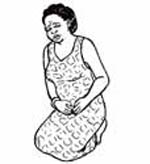3.2.1 Endometritis
Endometritis is an infectious process involving the inner wall of the uterus (the endometrium). It is commonly caused by bacteria ascending from the vagina, or bacteria transferred to the reproductive tract from the rectum and anus. Commonly known and avoidable risk factors contributing to the risk of endometritis include:
PROM is the subject of Study Session 17 of the Antenatal Care Module.
- Long labour: This risk can be managed by timely referral of women in prolonged labour.
- Prolonged and premature rupture of fetal membranes (PROM): The risk of infection is greatest if PROM has occurred long before the baby is delivered. You can reduce the risk by early referral.
- Repeated vaginal examinations: You can avoid this risk by not doing unnecessary internal examinations.
- Poor standard of hygiene and cleanliness during delivery: For example, insertion of an unclean hand into the vagina, or use of non-sterile instruments, can transmit infection.
- Pre-existing infection: Colonisation of the vagina and uterus from untreated sexually transmitted infections (STIs) or urinary tract infections (UTIs).
- Retained placenta or fetal membranes: The dead cells in these tisues favour the multiplication of bacteria.
- Manual removal of the placenta: If the umbilical cord tears (breaks) when you apply controlled cord traction to help delivery of the placenta, it may be retained and the woman may start to bleed profusely. In these circumstances, you will be forced to remove the placenta manually by inserting your fingers into the endometrial cavity, locating the placenta and removing it in pieces or in totality. In addition to the risk to the mother from the haemorrhage, there is also a risk of endometrial infection.
 Figure 3.4 Pain in the abdomen may be a sign of endometritis.
Figure 3.4 Pain in the abdomen may be a sign of endometritis. - Anaemia: Whether it is due to blood loss during pregnancy, labour and delivery, or due to nutritional deficiency, anaemia is a well known risk factor for endometritis and other types of puerperal infection.
- Traumatic delivery: (e.g. assisted by forceps, or by Caesarean section)
- Postpartum haemorrhage.
STIs are described in Study Session 31 of the Communicable Diseases Module; UTIs are covered in Study Session 18 of the Antenatal Care Module.
Signs of endometritis
A woman with endometritis typically has a fever of 38°C or higher, a rapid pulse and pain (tenderness) when you palpate the abdomen (Figure 3.4). Some women may also develop a yellowish, curd-like vaginal discharge which has a bad odour, whereas others have a little odourless discharge. In short, to assess the mother for uterine infection, ask if she has:
- History of fever or if she feels hot. Measure her temperature and she has a fever if it is equal to or greater than 38°C.
- Lower abdominal pain.
- Foul-smelling, curd-like discharge from her vagina.
![]() If the mother has even one of the above findings, assume she has endometritis and refer her urgently to the nearest hospital or health centre.
If the mother has even one of the above findings, assume she has endometritis and refer her urgently to the nearest hospital or health centre.
If you suspect a woman in the puerperium may have endometritis when you do your early postnatal visits, it is important that you refer her quickly for further treatment. If she has low blood pressure (diastolic less than 60 mmHg), you may begin an IV infusion of Normal Saline. Keep her lying flat with her legs lifted up by putting pillows underneath her knees (shock position), before transporting her to a health facility.
Which of the risk factors for developing endometritis can you, personally, do most about?
Ensuring the highest standards of hygiene and cleanliness during delivery; and avoiding, where possible, repeated vaginal examinations of the mother.
3.2 Puerperal sepsis and fever
